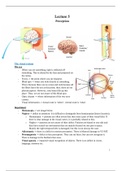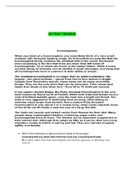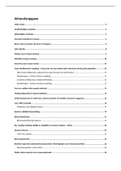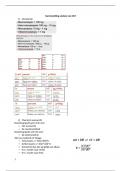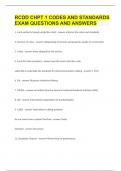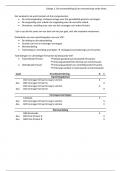Chapter 1 (Introduction)
1.1 Introduction
Mental lexicon = dictionary in our heads
1.2 What is psycholinguistics?
Psycholinguistics can be defined as the study of the mental representations and processes
involved in language use, including the production, comprehension and storage of spoken
and written language.
Comprehension is a bottom-up flow, processing based on information flow from lower level
of processing to higher level in this case from the input to an interpretation
There is evidence for top-down information flow too, processing guided by information flow
from higher levels to lower levels in this case when a listener starts to gain an understanding
of the sentence they are hearing this can influence the efficiency with which they recognize
subsequent words in the sentence
Interactive processing = information flowing in both directions
1.3 Who does psycholinguistics?
Contribute to knowledge of the workings of the mind
Neuropsychologists be interested in locating the language faculties within the physical
structures
Inform theories of language structure, it can provide the performance data to support
theories of competence, it can provide psychological validity for linguistics construct
1.4 How do psycholinguists do psycholinguistics?
Observation and introspection of daily behavior
Experiment
High-tech observation, measuring brain activity
, Chapter 2 (Planning utterances)
2.1 Introduction
Some sentences are complete, some stop and start again as the speaker changes his mind or
repairs something that he realizes he has got wrong or revises something that is incomplete,
others appear to be full of repetition and there are errors.
The speaker appears to provide a spoken form of punctuation by placing pauses at various
points in a passage.
Hesitation = failing to produce well-formed sentences
o Filled pauses = hesitation noises
o Drawing out of a sound
o Filler phrases / verbal fillers = ‘empty’ use i.e. like you know
2.2 A sketch of the production process
CONCEPTUALISATION Discourse model, situational and general knowledge, etc
Generating a message
Pre-verbal message
FORMULATION
(GRAMMATICAL and PHONOLOGICAL ENCODING) Grammar and lexicon
Producing structured language
Phonetic plan (internal speech)
Speech motor commands, etc
ARTICULATION
Producing speech sounds
External speech
Conceptualisation = notion or abstract idea of what we want to say
Formulation = put elements of language together that will express a idea, drawing on our
knowledge of our language, including vocabulary
Articulation = speak this utterance
2.3 Conceptualisation and planning
Not involve forms of language, but is all done ‘in the head’ in abstract terms
Pre-verbal message = result of the process of conceptualization
Mentalese = language of thought
Articulatory pause = very brief silence
1.1 Introduction
Mental lexicon = dictionary in our heads
1.2 What is psycholinguistics?
Psycholinguistics can be defined as the study of the mental representations and processes
involved in language use, including the production, comprehension and storage of spoken
and written language.
Comprehension is a bottom-up flow, processing based on information flow from lower level
of processing to higher level in this case from the input to an interpretation
There is evidence for top-down information flow too, processing guided by information flow
from higher levels to lower levels in this case when a listener starts to gain an understanding
of the sentence they are hearing this can influence the efficiency with which they recognize
subsequent words in the sentence
Interactive processing = information flowing in both directions
1.3 Who does psycholinguistics?
Contribute to knowledge of the workings of the mind
Neuropsychologists be interested in locating the language faculties within the physical
structures
Inform theories of language structure, it can provide the performance data to support
theories of competence, it can provide psychological validity for linguistics construct
1.4 How do psycholinguists do psycholinguistics?
Observation and introspection of daily behavior
Experiment
High-tech observation, measuring brain activity
, Chapter 2 (Planning utterances)
2.1 Introduction
Some sentences are complete, some stop and start again as the speaker changes his mind or
repairs something that he realizes he has got wrong or revises something that is incomplete,
others appear to be full of repetition and there are errors.
The speaker appears to provide a spoken form of punctuation by placing pauses at various
points in a passage.
Hesitation = failing to produce well-formed sentences
o Filled pauses = hesitation noises
o Drawing out of a sound
o Filler phrases / verbal fillers = ‘empty’ use i.e. like you know
2.2 A sketch of the production process
CONCEPTUALISATION Discourse model, situational and general knowledge, etc
Generating a message
Pre-verbal message
FORMULATION
(GRAMMATICAL and PHONOLOGICAL ENCODING) Grammar and lexicon
Producing structured language
Phonetic plan (internal speech)
Speech motor commands, etc
ARTICULATION
Producing speech sounds
External speech
Conceptualisation = notion or abstract idea of what we want to say
Formulation = put elements of language together that will express a idea, drawing on our
knowledge of our language, including vocabulary
Articulation = speak this utterance
2.3 Conceptualisation and planning
Not involve forms of language, but is all done ‘in the head’ in abstract terms
Pre-verbal message = result of the process of conceptualization
Mentalese = language of thought
Articulatory pause = very brief silence



